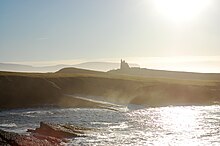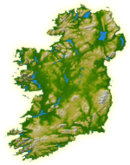Mullaghmore, County Sligo
Mullaghmore
An Mullach Mór | |
|---|---|
Village | |
 Mullaghmore Harbour | |
| Coordinates:54°27′59″N8°26′55″W/ 54.4664°N 8.4486°W | |
| Country | Ireland |
| Province | Connacht |
| County | County Sligo |
| Population | |
| • Total | 136 |
| Irish Grid Reference | G709577 |
Mullaghmore(Irish:An Mullach Mór,meaning 'the great summit')[2]is a village on theMullaghmore PeninsulainCounty Sligo,Ireland.It is a holiday destination with a skyline dominated byBenbulbenmountain. It is in thebaronyofCarburyand parish of Ahamlish.
History[edit]
From the 17th to the 19th centuries it was part of the large estate belonging to the Temple family in north Sligo. The land, some 12,000 acres (4,900 ha), was granted toSir John Temple(1600-1677),Master of the Rollsin Dublin. Sir John's direct descendant,The 3rd Viscount Palmerston(1784-1865), began the building ofClassiebawn Castleon the peninsula, a baronial-style house designed byJames Rawson Carroll.Lord Palmerston also built the stone-walled harbour in the village, which was designed by the marine engineerAlexander Nimmo.It was built between 1822 and 1841.
The Temples were mostly absentee landlords, with the estate being run initially by middlemen, and later by land agents, such as Stewart and Kincaid,[3]a Dublin firm with offices inSligo.[4]These agents, in their attempts to make the estates profitable, oversaw the "assisted emigration" that took place on the Palmerston and adjacent Gore-Booth (Lissadell) estate that began before theGreat Famineand continued until at least the 1860s.
Thus, in May 1862, a Sligo newspaper reported: "In accordance with a custom of some years' standing, about sixty persons have been selected for emigration from the Parish of Ahamlish... whose passages and outfit has been provided by his Lordship. They consist of twenty-four young girls, and twenty young men... [and] families who were wholly unable to support themselves... who had asked the favour of being sent out... The emigrants took their passages... this day, forLiverpool,en route forAmerica."[5]

Lord Palmerston presided over Mullaghmore and North Sligo during the worst years of the Great Famine of the mid-19th century. During the summer and autumn of 1847, nine vessels, carrying over 2,000 persons left Sligo port with tenants evicted and "shovelled out" from his Sligo estates. They arrived inCanadadestitute and half-naked. The city ofSaint Johnin the colony ofNew Brunswickhad to take many of Palmerston's evicted tenants into care and, outraged, sent a scathing letter to Palmerston expressing regret and fury that he or his agents, "should have exposed such a numerous and distressed portion of his tenantry to the severity and privation of a New Brunswick winter... unprovided with the common means of support, with broken-down constitutions and almost in a state of nudity... without regard to humanity or even common decency." The graves of many of these unfortunate victims can be seen today on the old quarantine station, now a museum, atGrosse Isle,in theSt. Lawrence RiveroppositeQuebec City.[citation needed]
Classiebawn was a favoured holiday retreat ofAdmiral of the FleetLouis Mountbatten.It was off the Mullaghmore coast in August 1979 that Mountbatten, along with his fourteen-year-old grandson Nicholas Knatchbull,Doreen KnatchbullandCounty Fermanaghteenager Paul Maxwell, were killed by a bomb planted by theProvisional IRA.
In 2007 it hosted the final stage ofRally Ireland.Sebastian Loeb wins the Rally of Ireland and went on to win his 4th World Championship title.[citation needed]
Surfing[edit]

Mullaghmore is abig wave surfingdestination.[6]On 8 March 2012, surfers and windsurfers from all over the world rode waves up to 15 metres (49 ft) high off Mullaghmore Head. These waves were about five metres (16 ft) less than the tallest wave ever recorded in Ireland inCounty Donegalon 13 December 2011, which was 20.4 metres (67 ft) high.[7][8]
The waves in Mullaghmore were generated by a complex weather system nicknamed the "Viking storm" leading to big wave conditions in the area for the month of March for 15 years. Some riders suffered bruising as well as broken bones and surfboards.[9][10]
A North American low-pressure system moved east and combined with anothercyclonein the Western Atlantic. This system moved into an area off the coast of Ireland that already had high waves owing to a series of strong systems the previous week. In addition, a stronganticycloneover theAzorescreated a large pressure gradient in the North Atlantic that directed astrong fetchtowards Ireland. There was also an extended fetch length in the North Atlantic in the direction of Europe while the swell was created. These combined conditions produced waves that were confirmed by satellite data on 7 March 2012 to have exceeded 15 metres (49 ft) in height.[11]
Amenities[edit]
Mullaghmore is served by two hotels, a seafood restaurant, a grocery shop, a spiritual retreat centre and a fish farm. There is also a variety of B&Bs in Mullaghmore. Mullaghmore's busiest times for trade and tourism are during the summer months of May, June, July and August, with the busiest being the weekend of the 12th of July, and the August Bank Holiday weekend. Most of these businesses close for the winter months, except the fish farm.
Mullaghmore also has a sandy beach nearly 2 km (1.2 mi) in length. There is no lifeguard on duty.[12]
Star Of The Sea Retreat and Conference Centre[edit]
The Star Of the Sea Building originally housed the coast guard in the nineteenth century, and the Sligo Sisters Of Mercy made it their home in August 1929. In the 1970s, the Convent began to welcome retreats. The entire building was overhauled and renovated in the 1990s. In 2010, The Mullaghmore Peace Garden was the latest addition to the facility. In 2015, the garden was visited by Prince Charles. In 2013, the Convent was handed over by the Sisters of the Western Province to the Bishop of Elphin and was run by God. Sr. Kathleen Rooney, R.S.M.. She ran the retreat until August 2020.[13]
Transport[edit]
The village is served by TFI Local Link Route 982, which runs fromBallyshannontoSligo.The bus arrives at Mullaghmore five times per day Monday to Saturday, and three times per day on Sunday.[14]For long-distance routes, the nearestBus Éireannstop is atCliffoney,around 5 kilometres (3.1 mi) distant, and is served several times per day.[15]
Notable people[edit]
- Joe McGowan(b. 1944),historianand author[citation needed]
See also[edit]
- List of towns and villages in Ireland
- Surfing in Ireland
- Wild Atlantic Way
- Visitor Guide to Mullaghmore
References[edit]
- ^"Population and Actual and Percentage Change 2011 to 2016".Central Statistics Office (Ireland).Retrieved3 September2017.
- ^MullaghmorePlacenames Database of Ireland. Retrieved: 2012-03-21.
- ^Norton, Desmond (21 April 2019).Landlords, tenants, famine: the business of an Irish land agency in the 1840s.University College Dublin Press.ISBN9781904558569.Retrieved21 April2019– via Google Books.
- ^Desmond Norton."On landlord-assisted emigration from some Irish estates in the 1840s"(PDF).Bahs.org.uk.Retrieved22 April2019.
- ^"Archived copy"(PDF).Archived fromthe original(PDF)on 9 April 2014.Retrieved8 April2014.
{{cite web}}:CS1 maint: archived copy as title (link) - ^"The best big wave surf spots in the world".SurferToday.Retrieved21 April2019.
- ^Giant 20-metre-high wave off DonegalIrish Times,2011-12-13.
- ^Donegal wave is a new high water markIrish Times,2011-12-14.
- ^Surfers' paradise: Best March conditions in 15 yearsIrish Times,2012-03-12.
- ^Last Minute XXL Entry From IrelandTransWorld Surfmagazine, 2012-03-12.
- ^Ireland gets XXL surfSurfline,2012-03-12.
- ^"Mullachmore strand".
- ^"Star of the Sea".
- ^"Route 982 Timetable"(PDF).
- ^"Archived copy"(PDF).Archived fromthe original(PDF)on 10 August 2013.Retrieved2 May2013.
{{cite web}}:CS1 maint: archived copy as title (link)



